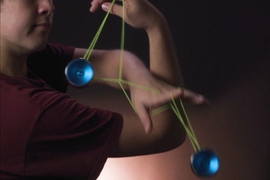Aaron Persad held up a clear cylinder with filled with water. The inconspicuous object had made a trip most people never will experience — orbiting the Earth aboard a space shuttle.
“I’m trying to determine how liquids behave in space,” explained Persad, a postdoctoral fellow working with Rohit Karnik, an associate professor of mechanical engineering. By understanding how liquids move in zero gravity or a near-freefall environment, Persad hopes to make more compact rockets and safer syringes for administering medication to astronauts.
Persad was one of the 44 participants in this year’s MIT Mechanical Engineering Research Exhibition (MERE), which was held on Sept. 28 in Walker Memorial. MERE is hosted by the Graduate Association of Mechanical Engineers (GAME) and MIT’s Department of Mechanical Engineering. Graduate students, postdocs, and Undergraduate Research Opportunities Program (UROP) students who have conducted research in mechanical engineering present their findings at MERE, using posters, live demos, videos, and interactive models.
The event is modeled after a typical poster session which most of the students will encounter throughout their careers at various scientific and engineering conferences.
“The idea with MERE is to empower graduate students and postdocs so they are more confident about their communication skills when it’s time for them to present their work at a conference or in front of potential industry partners,” explained Rashed Al-Rashed, a PhD candidate in mechanical engineering and one of the co-organizers of MERE.
In addition to providing students and early career researchers with valuable practice presenting their work, the event gave the entire mechanical engineering community at MIT an opportunity to learn about research from a variety of disciplines.
“MERE really demonstrates the breadth and diversity of the mechanical engineering research being conducted at MIT,” says Nick Fang, a professor of mechanical engineering and MERE’s faculty advisor. “It’s great at the beginning of the academic year to give these students and postdocs a chance to introduce themselves and share their passion for research to the community.”
The projects presented at this year’s MERE touched upon a diverse array of subjects — from cooling the electronic chips in cell phones to developing ankle-foot prosthetics for rock climbing. Projects were also related to research in various environments. While Aaron Persad was conducting research with applications in space, others focused on research in land and sea environments.
Kristen Railey, a PhD candidate in mechanical engineering, conducted research beneath the surface of the Charles River. She examined the acoustic features of unmanned underwater vehicles and how well she could detect and track them in a realistic environment. Meanwhile graduate student Carolyn Sheline presented a system model for low-cost, solar powered drip irrigation for use in farms located in Northern Africa and the Middle East.
Much of the research presented deals with pressing topics that could have a major global impact.
Graduate student Peter Godart, for example, hopes to help people after natural disasters by harnessing energy from debris. “I want to give people in the immediate aftermath of a hurricane the ability to provide clean water and electricity for themselves using locally sourced materials,” explains Godart. He plans on accomplishing this by making aluminum debris reactive with water using gallium and indium. The steam and hydrogen released from the reaction with water creates enough force to desalinate seawater and provide enough power to charge a phone.
Judges consisting of Course 2 alumni, current mechanical engineering faculty members, and staff listened to all the presentations and voted on which presenters were the best in certain categories. Awards were given to the following presentations:
- Best Overall: Daniel Gonzalez for “Extra Robotic Legs for Augmenting Human Payload and Positioning Capabilities.”
- Best Understanding: Chu Ma for “Acoustic far-field subwavelength imaging.”
- Highest Impact: Mo Chen for “Room-Temperature Quantum Error Correction with Nitrogen-Vacancy Centers.”
- Most Excitement: Cameron McBride for “Characterizing Resource Demand and Sensitivity in Biological Synthetic Circuits.”
- Best UROP: Carson Tucker for “Energy Consumption in a Batch Reverse-Osmosis Prototype,”
The runners-up included Tyler Hamer, Nicolas Selby, Aaron Persad, Kiarash Gordiz, Lup Wai Chew, Jerry Wang, Maytee Chanthrayukonthorn, Shuai Li, Shawn Zhang, and James Hermus. Honorable mention was given to Crystal Owens, Nina Petelina, Yoonho Kim, Thomas Toncagne-Dejean, Noam Buckman, Abhinav Gupta, Sara Nagelberg, Yi Xue, Caleb Amy, Peter Godart, and Dhanushkodi Miarappan.
The full-day event concluded with a keynote address by Karl Iagnemma SM ’97, PhD ’01, co-founder of nuTonomy, a company devoted to developing software for driverless cars. Iagnemma recounted his story of starting as an MIT graduate student focused on robotics and not interested in cars at all, to leading a company that has now given passengers in Las Vegas nearly 10,000 rides in autonomous vehicles. Having worked in both academia and industry, Iagnemma also detailed some of the key differences between life in the lab and life at a start-up.
“Developing planning and decision making technologies for autonomous vehicles is one of the great technical problems of this decade,” he said.
Despite the technical challenge posed by the problem, the technology holds tremendous opportunity to have a large positive impact on society, Iagnemma added. He said his main motivation in developing autonomous vehicle technology has been reducing the cost of both money and lives due to vehicle accidents.
“It’s often the case that hard problems are valuable problems,” he told the student audience. “I think that’s the case with driverless technology and I know that there are at least half a dozen other examples in this room today.”













